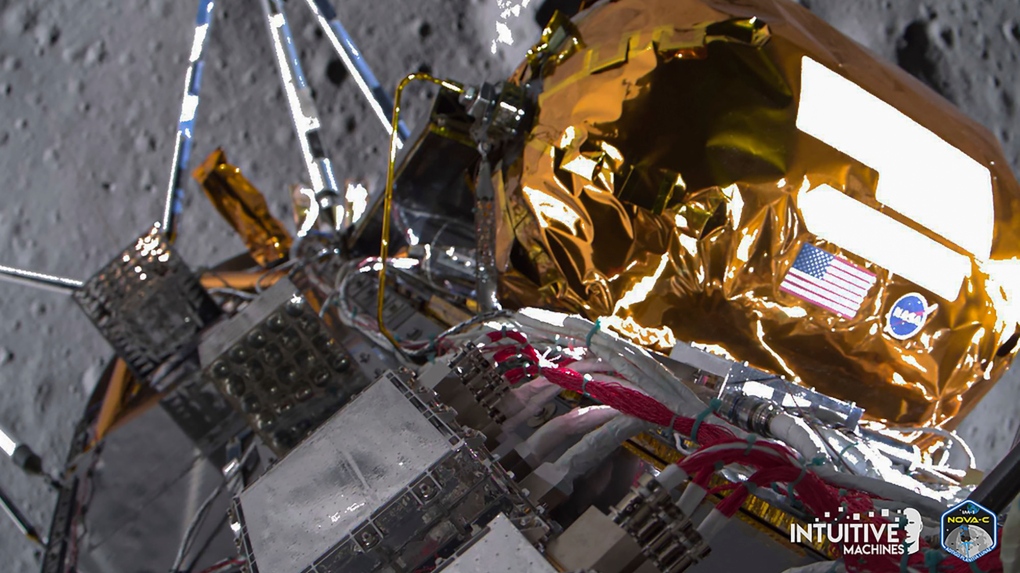Space talk: Former astronaut Julie Payette on Odysseus landing, total solar eclipse
An American spacecraft now sits at the south pole of the moon, making it the first United States moon landing since the Apollo program 50 years ago.
The Odysseus spacecraft, nicknamed Odie, is a joint project for NASA and a private, Houston-based company, Intuitive machines.
Julie Payette, a scientist and former Canadian astronaut, spoke with CTV Montreal anchor Mutsumi Takahashi about why this feat is significant and how it's laying the groundwork for the upcoming Artemis mission.
 This image provided by Intuitive Machines on Tuesday, Feb. 27, 2024 shows its Odysseus lunar lander over the south pole region of the Moon. (Intuitive Machines via AP)
This image provided by Intuitive Machines on Tuesday, Feb. 27, 2024 shows its Odysseus lunar lander over the south pole region of the Moon. (Intuitive Machines via AP)
She also took the opportunity to discuss the total solar eclipse that's happening on April 8 and how people can watch the rare event safely. Looking at the sun without protection can cause permanent eye damage, except for a brief moment of totality. When the sun is 100 per cent obscured by the moon, it is safe to not use special sunglasses.
The ISO 12312-2 standard for solar viewing glasses can be purchased online, Payette said. Space lovers can also make their own eclipse projector using a cardboard box and other household items.
While partial solar eclipses are more common, the last time Quebec saw a total solar eclipse was more than 50 years ago, in 1972. The next one will be in 2106.
More information about eye protection during a solar eclipse is available at science.nasa.gov/eclipses/safety and on the Canadian Space Agency's website.
Watch the video above for the full interview.
CTVNews.ca Top Stories

Donald Trump says he urged Wayne Gretzky to run for prime minister in Christmas visit
U.S. president-elect Donald Trump says he told Canadian hockey legend Wayne Gretzky he should run for prime minister during a Christmas visit but adds that the athlete declined interest in politics.
Historical mysteries solved by science in 2024
This year, scientists were able to pull back the curtain on mysteries surrounding figures across history, both known and unknown, to reveal more about their unique stories.
King Charles III focuses Christmas message on healthcare workers in year marked by royal illnesses
King Charles III used his annual Christmas message Wednesday to hail the selflessness of those who have cared for him and the Princess of Wales this year, after both were diagnosed with cancer.
Mother-daughter duo pursuing university dreams at the same time
For one University of Windsor student, what is typically a chance to gain independence from her parents has become a chance to spend more time with her biggest cheerleader — her mom.
Thousands without power on Christmas as winds, rain continue in B.C. coastal areas
Thousands of people in British Columbia are without power on Christmas Day as ongoing rainfall and strong winds collapse power lines, disrupt travel and toss around holiday decorations.
Ho! Ho! HOLY that's cold! Montreal boogie boarder in Santa suit hits St. Lawrence waters
Montreal body surfer Carlos Hebert-Plante boogie boards all year round, and donned a Santa Claus suit to hit the water on Christmas Day in -14 degree Celsius weather.
Canadian activist accuses Hong Kong of meddling, but is proud of reward for arrest
A Vancouver-based activist is accusing Hong Kong authorities of meddling in Canada’s internal affairs after police in the Chinese territory issued a warrant for his arrest.
New York taxi driver hits 6 pedestrians, 3 taken to hospital, police say
A taxicab hit six pedestrians in midtown Manhattan on Wednesday, police said, with three people — including a 9-year-old boy — transported to hospitals for their injuries.
Azerbaijani airliner crashes in Kazakhstan, killing 38 with 29 survivors, officials say
An Azerbaijani airliner with 67 people onboard crashed Wednesday near the Kazakhstani city of Aktau, killing 38 people and leaving 29 survivors, a Kazakh official said.


































